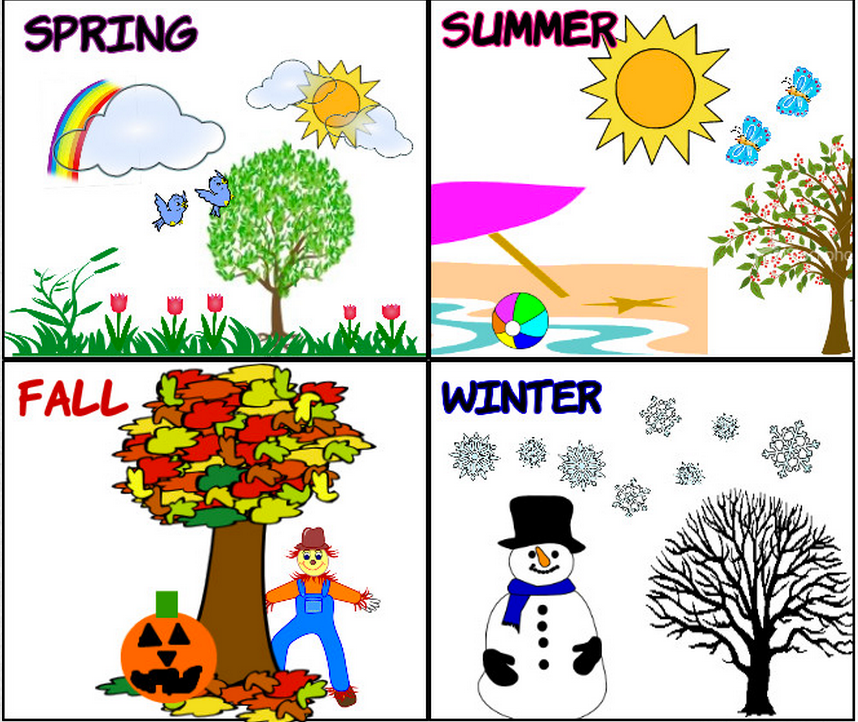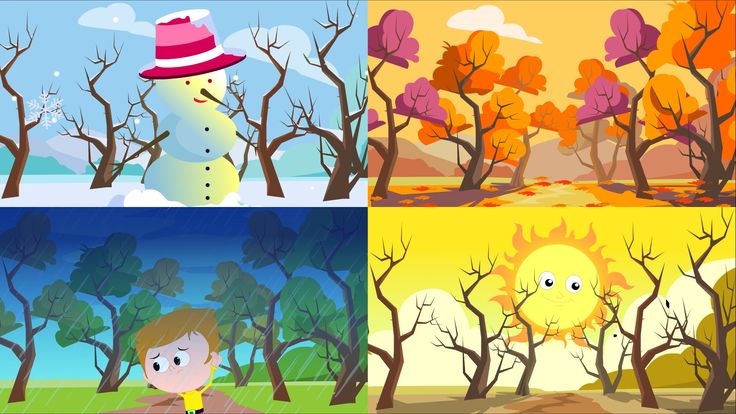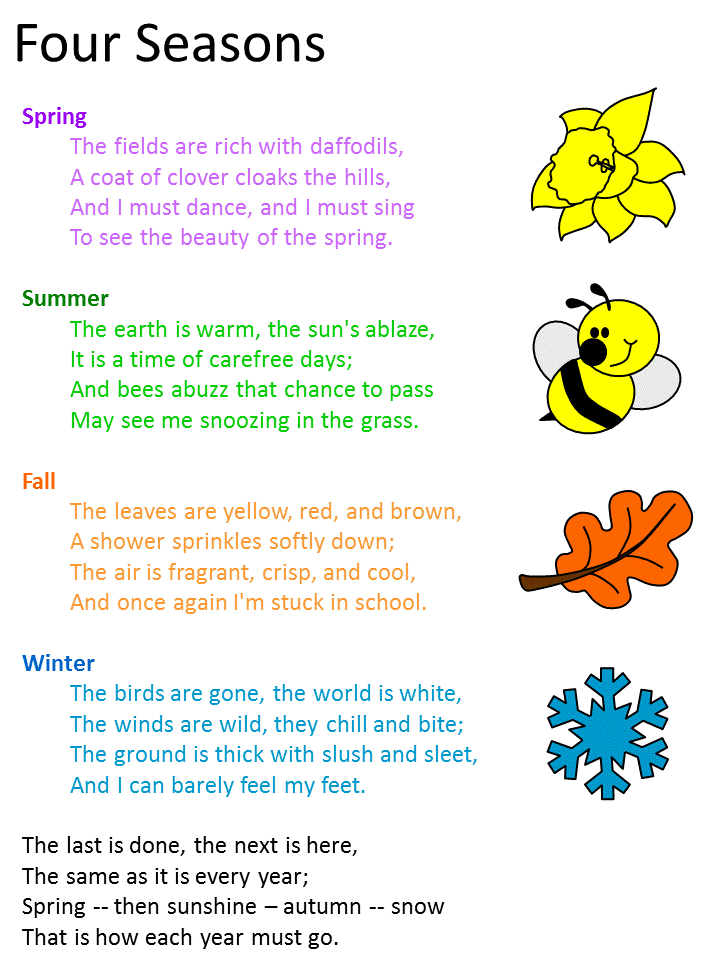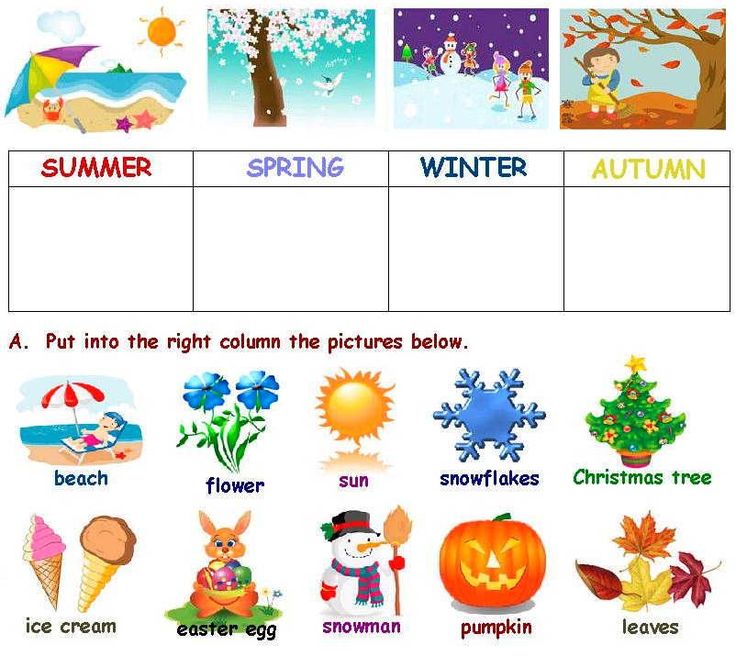Teaching seasons to kids: 10 Ways to Teach Your Child About the Seasons
10 Ways to Teach Your Child About the Seasons
As kids grow and explore, they’re sure to become curious about weather and to notice melting snow, warming air, and other signs of the changing seasons. For a young child, the gradual shift from one season to another can be a difficult concept to grasp. But it’s the perfect way to introduce a variety of scientific concepts while having fun along the way.
Download Article
Experiencing seasons with your child should be an exploration, not an explicit science lesson. “I think parents get a little worried about their own knowledge in science,” says Kimberly Brenneman, assistant research professor at Rutgers University with the National Institute on Early Education Research. “Don’t let fear stop you from exploring.”
The science of seasons includes lots of observation, outdoor exploration, and flat-out fun—for parents and kids alike. Get started with these 10 ideas from Brenneman and San Francisco Exploratorium teacher in residence Marilyn Austin.
- Keep a Science Journal. Once a week or once a month, go outside with your child and draw what you see. Focus on things that are tangible: the leaves on the trees, people’s clothing, jobs that people are doing (raking leaves, shoveling snow), animals and plants. The process of recording will strengthen his observation skills. Another journal option: focus on recording what happens to one deciduous tree in your backyard or on your street.
- Take a Sensory Walk. Walk around your neighborhood, or travel to a nearby park or forest preserve. As you walk, stop and watch, listen, smell, touch, and even taste. As you explore, expand your child’s vocabulary by asking questions. Is the temperature cold or freezing? Hot or boiling? Does the air taste fresh or damp? Do you feel rain, hail, or mist?
- Taste the Seasons. Once each season, go to a local farmer’s market and choose only fruits and vegetables that are in season.
What kind of foods can you eat in each season? Which season is the most delicious? Make a recipe book, complete with photos of the food you made, to document your tasty year.
- Celebrate Firsts. On your family calendar, mark the day when your child has to wear a sweater because it’s getting colder, or the first day of summer when she can wear her bathing suit. Mark the first day it’s hot enough to eat ice cream outside, and the first day she really enjoys hot cocoa. By the end of the year, your child will have calendar full of firsts!
- Seasonable Fashion. Introduce the idea of temperature by recording what your child wears alongside the temperature. Once a week during a changing season, such as from winter to spring, record the temperature and what he’s wearing. Then talk about the trend you see. As the temperature got higher, how did his clothing change? As the season changes from summer to fall, you can repeat the activity and talk about what happens to our clothing as the temperature drops.
- Study Sunlight. As days get longer, says Brenneman, kids should discuss why we protect ourselves from the sun. On a sunny afternoon, put a piece of colored paper in direct sunlight, and another piece under a cover. After a few hours, look at both pieces and discuss what happened.
- Create a Weather Tracker. Buy a calendar that you can dedicate to tracking weather. Each day, draw the weather on the calendar. Let your child come up with symbols for sunny, rainy, cloudy, snowy, and other types of weather (misty, foggy). At the end of each month, count the number of sunny, rainy, or cloudy days. Talk about what kind of weather you see during each season.
- Bulb Study. In October or early November, choose a flower, like tulips, that will bloom in early spring. Take one bulb apart so your child can observe the little roots and the beginning of a flower’s stem. Plant the rest in your backyard.
Record what happens through winter and into spring.
- Animal Spotting. Use binoculars to watch animals as the seasons change. Watch squirrels getting ready for winter by carrying acorns into trees. Observe birds migrating south. Or watch birds building nests in springtime. Books like Bear Snores On by Karma Wilson, Hibernation Station by Michelle Meadows, and Home for a Bunny by Margaret Wise Brown will help start a conversation about what animals do in different seasons.
- Leaf Walk. During fall, collect different kinds of leaves and sort them by how they feel, or their color or shape. Austin recommends making a poster board with different shapes so kids can match leaves with ovals, circles, squares, and triangles.
As you move through your child’s first experiences with seasons, don’t worry about explaining the scientific explanations. Instead, focus on the tangible observations.
Next Article:
Parts of the Eye
Why do we have seasons? lesson for children
Connect your children to the planet and learn why we have seasons. You can also use the seasonal lessons plans and printables for seasonal activities all year round.
Why do we have seasons?
Today, let’s learn about the seasons and why we have them. Plus, explore our resources for spring activities, summer activities, autumn activities, and winter activities.
Be sure to sign-up at the end of this article to receive all our free seasonal lesson plans, activities, and printables.
A seasonal story of a celestial dance
There are three main characters in our seasonal story: the Sun, the Earth, and our Moon.
The Moon moves around our Earth each day.
And together the Moon and our Earth move all the way around the Sun, over the course of the year.
The way the Sun, Earth, and Moon dance around together gives us our day and night; our spring, summer, autumn, and winter; and the cycle of the natural year.
Four seasons in one year
It takes 365 days for the Earth to travel around the sun – one year.
During this year, as the Earth moves around the sun, we have our seasons: spring, summer, autumn, winter.
One important thing to know is that the Earth is tilted. As it moves around the sun it doesn’t sit straight upright with the North Pole exactly at the top and the South Pole exactly at the bottom. Instead, it leans to one side a little.
This tilt is very important, because it means at certain times of the year more of one part of the Earth is facing the sun than at other times. This tilt gives us our seasons.
In our Spring Workshop we learned that in June the northern part of Earth is titled towards the sun, and this means we get the most hours of sunshine – giving us short nights and the longest day of the year. It’s when people living in the northern part of Earth have summer.
In September, the Earth has moved further around the sun, and now the tilt means that the sun is facing right at the middle of the Earth. The rays of the sun are shining on the northern and southern parts of the Earth equally. This means we get about the same number of hours of day time and night time. We call this time of year autumn, and the day of the year when we have the most equal day and night is called the Autumnal Equinox. This year that day is on September 22nd.
After the Autumnal Equinox the tilt of the Earth means we will get fewer of the sun’s rays shining on our part of the world each day.
People living in the southern hemisphere have their seasons at the opposite time of year to us, so when we are having autumn, they are having spring.
Watch this video to see the movement of the Earth around the sun.
Follow the sunset
You might like to track what time the sun sets each day this week. Does it get earlier or later each day? [For safety reasons, tell children not to look directly at the sun.]
Talking points for every season
You can use these questions for circle time to start a conversation about the changes each season:
What happens this season where you live?
What do you notice happening in your garden or in the woods?
What foods do you see in the market?
What are the bird and insects and other wild animals doing at this time of year?
Spring resources and activities
Download the complete Seasons School Spring Curriculum here
Spring Unit, Egg Unit, Seeds and Shoots Unit, Daffodil Unit
Make a spring nature table
Try these spring math ideas
Try these spring literacy ideas
Make these spring crafts
Summer resources and activities
Download the complete Sunflower School curriculum
Celebrate the Summer Solstice
Try these summer sensory play ideas
Try these summer art ideas
Autumn resources and activities
Download the complete Seasons School Autumn Curriculum here
Celebrate the autumn equinox
Make an autumn nature table
Try these autumn play ideas
Try these autumn math ideas
Try these autumn literacy ideas
Go on an autumn treasure hunt
Winter resources and activities
Download the Ice and Snow Unit here
Download the Winter Workshop here
Try these winter sensory play activities
Try these winter literacy activities
Try these winter math activities
Try these winter art activities
Try these winter science activities
Free Forest School and Garden Classroom resources!
Join my weekly email service and I’ll send you FREE printables, lesson plans, and activity ideas that you can use with your children in your forest school and garden classroom.
Seasons School is NurtureStore’s year-round program of living and learning with nature. Our activities and resources focus on hands-on, nature-based learning that connects children with the natural environment.
If you’re looking for nature study lessons, arts and craft projects, campfire recipes, foraging ideas, outdoor math and literacy activities, outdoor games, and ways to explore forests, gardens, and outdoor spaces – think of NurtureStore as your forest fairy godmother!
Whether you’re in a forest school or outdoor classroom, running a school gardening club, bringing nature lessons into your class, home educating with nature, or wanting to connect with the great outdoors at the weekend, you will love the Seasons School ideas.
Pop your email address into the box below and I’ll send you your free resources.
* By subscribing, you consent to our use of your personal data as per our Privacy Policy, which includes agreeing to receiving interest-based email from us.
Learning the months and seasons for children in pictures
06/15/2021
As children grow up, many questions arise: “What is it?”, “What is it for?” etc. Adults should pay more attention to a child who is actively developing. In the article, we will consider tips on how to easily and quickly teach kids the names of the months of the year.
Children are interested in various topics, including serious ones. When parents encounter something like this, they begin to wonder how to properly answer or explain. For example, they hear the question: “Mom (dad), what is November?”. How to explain to a child in an accessible way that there are 12 months in a year, of which 3 are winter, 3 are spring, 3 are summer and 3 are autumn? That each month has a name, that January is a winter month and July is a summer month? How to learn the names of all months with a child? And not just to find out, but to teach them to distinguish them by specific features?
When to start teaching?
You can start explaining to children the difference between months and seasons from the age of 3-4.
How to start learning?
It is necessary to begin the explanation with what a month is as a whole, how many of them are in a year, and why it is customary to divide a year into seasons. Then you need to talk about the generally accepted order and begin training with the study of the months, starting from the first – January.
Please note! A quick way to remember the number of days in a month is to make a fist and look at the bones. The first is January. A month on a bone has 31 days, on a hollow – 30.
Names of the months in children’s pictures
All children love games. It will be more interesting and easier for the kid to learn the names of the months if he is shown plot illustrations or presentations.
Finding illustrations about each month and showing them to the child, the parent will be able to fix their names in his memory. To do this, you need to pick up pictures that show the life of animals in each of the seasons, the type of clothing for each season, etc.
To interest the son (daughter), the presentation should be colorful. You can also display the features of each month. For example, September – the leaves fall, the school year begins, and the children go to school. In presentations, you can focus on the holidays. For example, December is the New Year, decorating the Christmas tree and the house. Be sure to include the child’s birthday in them – he knows and remembers this day for sure.
Winter months
The child needs to be explained that there are 3 winter months – December (ends the year and begins winter), January (begins the year) and February (the most severe month, with blizzards and snowfalls).
Spring months
The first spring month is March. This is the period when primroses appear – snowdrops. The second month is called April. This is a period of changeable weather: now the sun is shining, now it is raining. The third month – May – is the time when nature begins to dress the forest. Plot illustrations also fit the explanation.
Summer months
June is the first month of summer. In ancient times it had the name “worm”. This month has the longest day and shortest night of the year – June 22nd. June is followed by July – the month when the linden blossoms intensively. Summer ends – August – time to harvest. In addition to pictures, you can pick up riddles that describe each month.
Autumn months
There are also 3 autumn months: September (early autumn), October (golden autumn) and November (late autumn). To describe the season, you can pick up signs for each month.
How to learn the names of the months from books
Experts recommend buying children’s educational books about seasons and months. Such benefits in an accessible form explain to the kids the features of nature, the signs of the months. Some editions of such books contain tasks to consolidate the material, which will strengthen the memory of the studied topic.
Verses can help you learn the names of the months. After studying them, memory will improve. You need to buy special literature with poems, fairy tales and stories about 12 months. The book “365 Bedtime Stories” proved to be excellent. The pictures in it are sorted by seasons, and each page corresponds to one calendar day. The book contains poems and stories that fully reveal the theme of 12 months. It is great for learning with toddlers. No less useful is the encyclopedia “Seasons” with answers to many questions.
Learning the names of the months by playing
Theatrical scenes will help the child remember the names of the months and seasons.
An excellent way to study and memorize the months is a didactic game. They are designed specifically for preschool children. They also demonstrate relationships with the environment, develop memory and logic.
Information that is interesting to children is remembered quickly. They always want to learn a lot of new things, so they ask adults questions and get to know the world. Children are good conversationalists who know how to listen. The study of months is an entertaining topic for a child. He will be happy to study it with mom or dad.
How to explain the seasons to a child: instructions for parents
At first glance, it may seem that the topic is simple and obvious: it is snowing, which means winter; butterflies fly, it means summer.
Here are some ways to help your child understand the seasons.
Observe
A one-year-old child can be introduced to some simple concepts: heat, cold, dry, damp, sunny, overcast, rain, snow, thunderstorm, thunder and sun.
Before the walk, explain why you need to dress the way you do. For example, “put on rubber boots, because it’s raining and puddles outside, so your feet won’t get wet.” Associative and logical connections will be fixed in the child: rain – boots, rain happens when there are yellow leaves on the street or flowers appear, that is, in autumn or spring. When the rain is warm, it’s summer. In winter it is almost non-existent.
Play
This is the easiest way for a child. Most preschool games have clear pedagogical goals. For example, in the game “What is superfluous?” develops observation, logical thinking and mindfulness.
<
Items
Game for children from 3 years old. An important condition is that the child must know the seasons, signs and clothes. You can make the game yourself or buy it in the store. Pictures need to be folded side by side or attached like puzzles.
The task is to find out the season in the big image and find all the small images that fit. It can be elements of clothing, precipitation, some typical signs.
What is it?
A game for children from 3 years old who are familiar with the seasons. An adult shows the child a picture, and he must guess what time of the year is guessed. For example, a smart Christmas tree is winter, a green Christmas tree is any.
Dressing up for a walk
Game for children from 3 years old. You can use pictures or items of clothing of a person or doll.
Ordinary children’s amusements are suitable for studying the seasons: lotto, dominoes, puzzles, coloring books, stencils. They can be customized to almost any theme.
Watch cartoons
Another easy way. Important: do not leave the child alone with his thoughts, make sure that he correctly understood the meaning and plot of the cartoon. At the end, ask clarifying questions or offer to act out a scene, make characters, or draw a main idea.
Cartoons with episodes about the seasons:
- Curiosities,
- Aunt Owl Lessons,
- Little Boys,
- Three Kittens,
- Three Cats.
In addition to special educational episodes, you can watch regular cartoons and find out what season they show, for example, in “The Gray Neck”, “12 Months” or “Prostokvashino”.

<
Read books
Here the principle is the same as with cartoons: there are specialized series and manuals, and there are simple works of art, on the pictures of which you can practice. The task on the level above is to determine the time of the year by ear according to the description.
Do crafts
A way to develop fine motor skills, creative thinking and memorization. Crafts can be from any materials. Be sure to say what you are doing now and why. For example, “rolling a plasticine ball to make a snowman.” This is a great way to develop speech and thought process: this way it becomes clear what elements the whole consists of. A snowman is three balls, a bucket with a handle, a carrot, eyes made of coal, a mouth made of several berries, hands made of branches.
Cotton wool snowman
Guessing riddles
Children can solve easy puzzles from the age of two or three, when the riddle is presented with a simple description.
At the age of three or four, children master riddles in verse, but of a small size. These are the classics “A pear is hanging – you can’t eat it” and “Beauty is sitting in a dungeon, and a scythe is on the street.”
Children over five years old can be offered longer options, for example:
The snow is melting, streams are ringing,
The streams are getting stronger.
And the rooks are already flying
To us from distant countries.
<
Memorize poems
Children who already know how to speak are able to memorize couplets and quatrains at the age of three. Children who have not yet learned to speak start their journey later, but also memorize first couplets, then quatrains and more complex works.
Poems can be short and concise, for example:
Spring came after winter, and it became warmer,
The snow melted and disappeared, as if it never happened!
It is important that the lines deal with the seasons, their alternation and signs.







 What kind of foods can you eat in each season? Which season is the most delicious? Make a recipe book, complete with photos of the food you made, to document your tasty year.
What kind of foods can you eat in each season? Which season is the most delicious? Make a recipe book, complete with photos of the food you made, to document your tasty year. 
 Record what happens through winter and into spring.
Record what happens through winter and into spring. 
